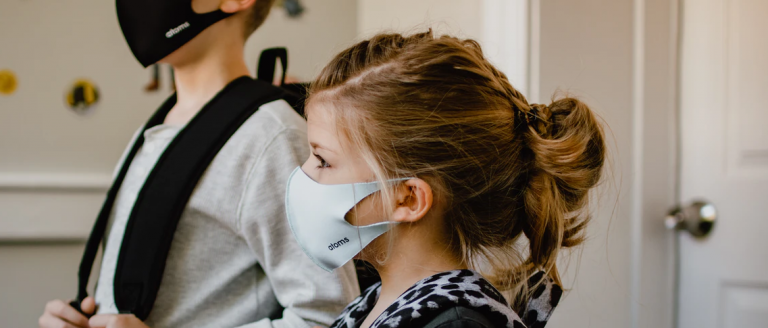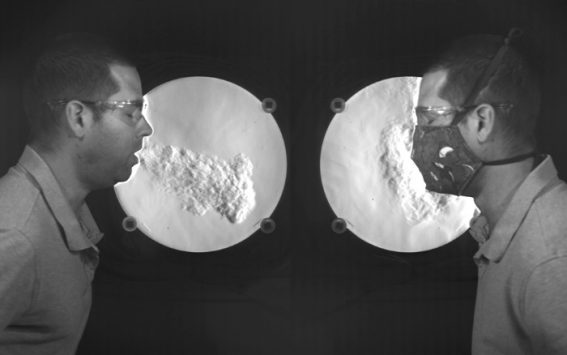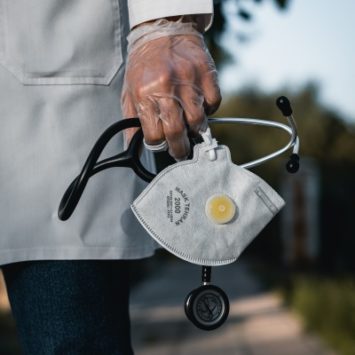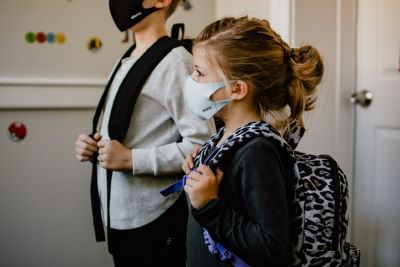
Since the beginning of the pandemic, there has been a raging — sometimes ill-informed — debate over the effectiveness of face masks as protection against SARS-CoV-2, the virus that causes COVID-19.
Initially, there was limited evidence to support broad masking policies for the general public, and the Centers for Disease Control and Prevention recommended masks only for those infected and medical providers treating them. On April 3, 2020, the CDC reversed course and recommended that everyone wear face coverings in public, citing new data that showed a “significant portion” of people infected with the coronavirus lack symptoms but can spread the virus to others.
Since then, a growing body of evidence supports the use of masks to slow the spread of COVID-19, as we reported in March.
Numerous lab studies, for example, show that high-quality, well-fitting masks can partially block exhaled respiratory droplets, which are thought to be the primary way the virus spreads — and may offer some protection to the wearer. In one CDC study, N95 respirators performed the best in preventing the spread of particles from a simulated cough — blocking 99% of the particles — while medical masks blocked 59% and a cloth mask blocked 51%. (See SciCheck’s “The Evolving Science of Face Masks and COVID-19.”)
 But the effectiveness of masks is now being challenged again — fueled, in part, by contradictory signals sent by the CDC.
But the effectiveness of masks is now being challenged again — fueled, in part, by contradictory signals sent by the CDC.
On May 13, the CDC updated its guidance to say “fully vaccinated people no longer need to wear a mask or physically distance in any setting.” But two months later, with COVID-19 cases on the rise and the delta variant becoming dominant in the U.S., the CDC changed course again — recommending “fully vaccinated people to wear a mask in public indoor settings in areas of substantial or high transmission.”
With each decision, federal health officials have said mask guidelines are based on the “evolution of the science,” as Dr. Anthony Fauci, the director of the National Institute of Allergy and Infectious Diseases, once put it.
The evolving science also has offered an opportunity for those peddling misinformation to distort the facts at every turn.
“It’s not healthy for these students to be sitting there all day, 6-year-old kids in kindergarten covered in masks,” Florida Gov. Ron DeSantis said in a July 28 speech in Utah, repeating an unsubstantiated health claim that we debunked before.
On Aug. 11, Sen. Rand Paul was kicked off YouTube for a week after making inaccurate claims about the effectiveness of face masks. “Most of the masks you get over the counter don’t work. They don’t prevent infection,” Paul said in the video, citing as evidence a Danish study that, as we wrote last year, has been distorted by critics of mask mandates.
In reviewing our work on masking, we have found that false and misleading claims about face masks tend to fall into four categories of misinformation: distortions of science, misrepresentation of government guidance, claims that mask-wearing has been proven to be ineffective and claims that mask-wearing increases your health risk.
There is some overlap of categories. For example, claims that distort scientific research do so to conclude, incorrectly, that masks have proven to be ineffective or even dangerous.
Below we summarize some of our work over the past 16 months, based on the categories of misinformation about masking.

Distortions of Science/Mask-Wearing Proven to Be Ineffective
CDC study distorted to claim masks have ‘negligible impact’
Claim: Some conservative outlets and social media users in March falsely claimed that the CDC found face masks have a “negligible impact” on COVID-19 outcomes and that mask mandates “made no statistical difference.”
Facts: The CDC study actually found that state-issued mask mandates were associated with significant decreases in daily COVID-19 case and death growth rates. The findings supported the premise that mask requirements help limit the potential exposure to the SARS-CoV-2 virus, which therefore reduces the spread of the disease, COVID-19.
The study found that mask mandates were associated with a 0.5 percentage point decrease in daily COVID-19 case growth rates within the first 20 days. The reductions in growth rates increased with time, reaching 1.8 percentage points within 81 to 100 days after implementation.
Yet, conservative outlets claimed the CDC said masks had “little” impact, wrongly equating the decrease in the growth rate of daily cases and deaths with a decrease in the number of cases and deaths.
“Because the growth rate is exponential,” the impact compounds, José Luis Jiménez, an analytical and atmospheric chemist at the University of Colorado Boulder who was not involved in the study, told us. “So, it’s kind of like your mortgage — you change your interest a little bit, and then you save a ton of money. Because the cases compound.”
For more, see “Posts Distort CDC Study Supporting Mask Mandates to Reduce COVID-19,” March 19
Danish study didn’t prove masks ‘don’t work’
Claim: News of the results of a randomized controlled trial in Denmark testing a face mask intervention led some to wrongly conclude that masks are ineffective against the coronavirus. Social media posts, for example, cited the study to claim that the trial “proves masks offer NO protection from COVID” or that masks “don’t work.”
Facts: Scientists say that’s the wrong takeaway — and even the authors of the study say the results shouldn’t be interpreted to mean masks shouldn’t be worn.
The Danish trial was published in Annals of Internal Medicine on Nov. 18 along with two editorials to provide more context to the findings.

The trial evaluated whether giving free surgical masks to volunteers and recommending their use safeguarded wearers from infection with the coronavirus, in addition to other public health recommendations. The study didn’t identify a statistically significant protective effect for wearers, but the trial was only designed to detect a large effect of 50% or more. And the study didn’t weigh in on the ability of masks to prevent spread of the virus from wearers to others, or what’s known as source control, which is thought to be the primary way that masks work.
As a result, the most that can be said is that this particular study didn’t find that the face mask intervention had a large protective effect for wearers — not that masks provide no protection at all or don’t offer benefits to others. And at the time, Danish authorities were not recommending masks to the general public, so most people in the trial were likely to have encounters with non-mask wearers.
For more, see “Danish Study Doesn’t Prove Masks Don’t Work Against the Coronavirus,” Nov. 25, 2020
Fauci followed science, CDC recommendations on masking
Claim: “Fauci lied” about face masks when he wrote in a Feb. 5, 2020 email that “[masks] are really for infected people to prevent them from spreading infection to people who are not infected rather than protecting uninfected people from acquiring infection.”
Facts: Fauci’s public statements early in the pandemic on masking have been repeatedly distorted. His remarks on masks throughout the pandemic have been consistent with what was known at the time about the transmission of SARS-CoV-2.
The Feb. 5, 2020, email, which was released in response to journalists’ Freedom of Information Act requests, was written before the CDC had begun recommending the use of face masks for the general public. At that early point in the pandemic, the CDC recommended face masks for health care workers and those who had COVID-19 and were showing symptoms.
On April 3, the CDC reversed its earlier position and announced that it would recommend that people wear face coverings in public, citing new studies on the transmission of the virus that causes COVID-19.
So, Fauci’s email was consistent with public guidance at the time. He was also being consistent when Fauci told “60 Minutes” in March 2020 that “masks are important for someone who’s infected to prevent them from infecting someone else.”
For more, see “Viral Posts, Pundits Distort Fauci Emails,” June 4, “Video Wrong About Fauci, COVID-19,” Feb. 3, and “Outdated Fauci Video on Face Masks Shared Out of Context,” May 19, 2020
Misrepresenting findings on use of personal protective measures
Claim: In a viral video, former television journalist Ben Swann misleadingly argued that face masks have been proven to be ineffective in stopping the spread of COVID-19, citing 2019 and 2020 studies that he claimed showed “there was no significant difference by wearing N95 respirator masks.”
Facts: The 2019 study looked at the effect of N95 respirators compared with surgical masks to prevent health care workers from getting the flu and “other viral respiratory infections in geographically diverse, high-exposure, outpatient settings.” It did not examine the use of masks as source control for containing the spread of a virus in the general population. It also didn’t include a group of study subjects who didn’t wear masks at all, so the outcomes of those who wore surgical masks or N95 respirators can’t be compared with outcomes for non-mask wearers.
The 2020 “study” is actually a review of several studies.
It included only one study that wasn’t focused on health care workers. Published in 2009, that study looked at the use of masks in households with a sick child and found that if masks aren’t used regularly and correctly, they won’t be effective in controlling the spread of seasonal viruses. “However,” the study found, “during a severe pandemic when use of face masks might be greater, pandemic transmission in households could be reduced.”
For more, see “Video Misrepresents the Science Behind Face Masks,” July 24, 2020
Distortions of Science/Mask-Wearing Increases Health Risk
Bogus ‘study’ — later retracted — gives rise to false claims of harm
Claim: In April, viral headlines wrongly claimed that a “Stanford Study” proved that masks are ineffective and dangerous. Among other things, the paper said that masks “restrict breathing, causing hypoxemia and hypercapnia.” Hypoxemia is the term for insufficient oxygen in the blood; hypercapnia is the presence of too much carbon dioxide in the bloodstream.
Facts: The paper cited in the viral claims was not an original “study,” but one person’s hypothesis — or proposed explanation — based on a review of some previous literature. It was first published online in November by the journal Medical Hypotheses, but was later retracted by the journal’s publisher, which apologized to readers.
As for the accusation that masks cause unsafe oxygen levels, experts have repeatedly rebuffed that claim.
“For many years, health care providers have worn masks for extended periods of time with no adverse health reactions,” the Mayo Clinic Health System notes. “The CDC recommends wearing cloth masks while in public, and this option is very breathable.”
For more, see “Stories Falsely Cite ‘Stanford Study’ to Misinform on Face Masks,” April 22
Unsupported claim on facial deformities
Claim: In a Feb. 11 video live-streamed on Facebook and viewed more than 70,000 times, chiropractor Eric Nepute rattles off a list of 20 arguments against wearing face masks, including this distortion: “Facial deformities. Masking children triggers mouth breathing, which has been shown to cause narrowing of the face, narrowing of the mouth, high vaults in the palate, dental malocclusions — and the list goes on and on. This is according to the Journal of General Dentistry. They say you shouldn’t wear one.”
Facts: Nepute — who in April was charged by the Federal Trade Commission with violating consumer protection laws by deceptively marketing products to treat or prevent COVID-19 — is referring to the Academy of General Dentistry’s journal, which did not say not to wear a mask. The report being referenced didn’t evaluate masks at all.
Instead, the 2009 report looked at the implications of mouth breathing in children.

Dr. Callan White, a dentist and national spokesperson for the Academy of General Dentistry, told us that the video’s claim requires “several jumps.” There is no scientific evidence showing that children resort to exclusively breathing through their mouth while wearing a mask, he said, and that they do so for long enough to mirror children who experience chronic mouth breathing.
“Children who suffer from these conditions aren’t able to breathe through their nose at all, or very little, at all times. This condition creates the most harmful effects at night while the child is sleeping,” he said. “There is a significant difference in frequency and duration of the habit” of mouth breathing due to wearing a mask.
False claim about masks causing ‘bacterial infections’
Claim: Nepute also wrongly claimed that “oh, by the way, that’s the No. 1 thing that killed everybody during the Spanish Flu of 1918. Not the virus, but the bacterial infections. These masks are causing this.”
Facts: In 2008, researchers at the National Institute of Allergy and Infectious Diseases published a study that found that most deaths from the 1918 flu pandemic likely resulted from secondary bacterial pneumonia after contracting the flu.
“The pneumonia was caused when bacteria that normally inhabit the nose and throat invaded the lungs along a pathway created when the virus destroyed the cells that line the bronchial tubes and lungs,” the National Institutes of Health said in a release explaining the study.
So to suggest the flu wasn’t involved in those deaths is wrong. Furthermore, that study made no mention of masks.
For more, see “Video Airs False, Misleading Claims About Face Masks,” Feb. 17
Gas detector ‘test’ reaches flawed conclusion
Claim: In a video, Jeff Neff — a firefighter and president of the borough council in Sewickley, Pennsylvania — used a device for detecting gas levels to wrongly suggest that face masks reduce oxygen levels to dangerous levels.
Facts: Thomas Fuller, a professor of health sciences at Illinois State University who reviewed the video for FactCheck.org, told us Neff was wrongly measuring his own exhaled breath. Fuller said oxygen molecules are small enough to pass through such masks when the wearer inhales.
“He’s really misinformed and ill-qualified” to be conducting such a test, said Fuller, who is a member of the American Industrial Hygiene Association.
MSA Safety, the manufacturer of the device used by Neff — an ALTAIR 5X Multigas Detector — also told us that its product is “not designed for the use shown” in the video.
For more, see “Video Presents Flawed Test on Masks, Oxygen Levels,” July 2, 2020
Misleading claim of ‘greater risk of contamination’
Claim: In a viral video — which racked up hundreds of thousands of views on Facebook and YouTube, before the latter removed it for violating the platform’s community standards — Ben Swann, a former television journalist, claimed “improper use of a face mask actually puts you at greater risk of contamination,” citing a “study that was also done in 2020 … by a group of researchers in Hong Kong.”
Facts: This was a review of previously completed studies, not a new study, and it looked largely at how effective various methods — including wearing a mask, hand hygiene, covering coughs and sneezes, and cleaning surfaces — would be in responding to an influenza pandemic.
The possibility that using a mask improperly could put someone at risk of contamination is mentioned in one sentence in the paper, which cites interim guidance from the World Health Organization to address the H1N1 pandemic in 2009. That two-page WHO paper doesn’t explain what that caution is based on, but it does lay out best practices for wearing masks in the general public.
“If masks are worn, proper use and disposal is essential to ensure they are potentially effective and to avoid any increase in risk of transmission associated with the incorrect use of masks,” such as touching the mask or reusing single-use masks, the WHO advises.
2015 study doesn’t support claim of risk
Claim: In his video, Swann also cited a 2015 study as evidence that masks increase the risk of contamination, saying: “Not only does wearing a cloth mask not prevent the spread of a virus, it can actually put you at greater risk for catching the virus.”
Facts: Again, this study did not look at the effect of masks as source control in slowing the spread of a virus, which is the reason the CDC recommends wearing them. It looked at how effective masks were in keeping health care workers from getting sick. It didn’t include a group who wore no masks, so it couldn’t say whether or not cloth masks might provide more protection than no mask at all.
The study did find that “[m]oisture retention, reuse of cloth masks and poor filtration may result in increased risk of infection.” But it said that “[f]urther research is needed to inform the widespread use of cloth masks globally.”
Also, the authors of that study released a statement this year to clarify questions about their 2015 findings in relation to COVID-19. They explained that, in their study conducted in Vietnam, the cloth masks may not have been washed well enough and that the effectiveness of a mask could change depending on the material and the number of layers used.
Raina MacIntyre, who was lead researcher on that study, clarified to FactCheck.org in an email, “The findings of the study are not translatable to the community, or to all cloth masks.” She added, “There is also the matter of source control, which is preventing outward transmission from an infected person. A face covering provides a physical barrier.”
For more, see “Video Misrepresents the Science Behind Face Masks,” July 24, 2020
Mask wearers can’t infect themselves with SARS-CoV-2
Claim: In a falsehood-filled documentary called “Plandemic,” Judy Mikovits, a former chronic fatigue researcher, wrongly suggested that people wearing masks could infect themselves with their own breath. “You’re getting sick from your own reactivated coronavirus expressions and if it happens to be SARS-CoV-2, then you’ve got a big problem,” she said.
Facts: Experts told us the implication that simply breathing through a mask could lead to self-infection doesn’t square with science. Lisa Brosseau, an expert on respiratory protection and infectious diseases, said viruses “require living cells in order to replicate.”
“There is nothing magical about our breath that ‘activates’ or ‘reactivates’ a virus,” Brosseau said.
For more, see “The Falsehoods of the ‘Plandemic’ Video,” May 8, 2020
Misrepresentation of Government Guidance
Misrepresenting mask mandate on public transit
Claim: Unreliable websites and a popular YouTube video spread the false claim that the CDC issued a “demand” that those using public transportation must wear two masks.
Facts: The CDC issued an order on Jan. 29 “requiring the wearing of masks by people on public transportation conveyances or on the premises of transportation hubs to prevent spread of the virus that causes COVID-19.”
The CDC order for public transportation riders defined “masks” as “a material covering the nose and mouth of the wearer, excluding face shields.” A footnote added: “Masks can be either manufactured or homemade and should be a solid piece of material without slits, exhalation valves, or punctures.”
The CDC’s guidance issued with the order that said cloth masks, among other attributes, “should be made with two or more layers of a breathable fabric that is tightly woven.” But a mask “made with two or more layers” is not the same as two masks, as the video and headlines claimed.
For more, see “Headlines Distort the Facts on CDC Mask Order,” Feb. 5, 2021
Misrepresenting FDA’s EUA for non-surgical face masks
Claim: A meme suggested that face masks are useless against COVID-19, citing a warning label required by the Food and Drug Administration for non-surgical face masks.
Facts: On April 24, 2020, the FDA issued an emergency use authorization for non-surgical face masks that were “only authorized for use by the general public and health care personnel as source control” — which means “preventing the transmission of infection through a person’s respiratory secretions which are produced when speaking, coughing, or sneezing.” The non-surgical masks were “not authorized to be personal protective equipment” by medical personnel.
The EUA specified that makers of non-medical masks marketed for use by the public make clear to consumers that the masks are not meant to be used in a clinical setting. The memes twisted that FDA-required warning to claim that masks don’t work at all.
For more, see “Meme Misconstrues Efficacy of Face Masks in Spread of COVID-19,” July 9, 2020
Distorted claims on increased risk of COVID-19
Claim: In his video, Nepute also cited “public health officials of Ontario” to claim that “mask use by the general public could be associated with the … theoretical elevated (risk) of COVID-19.”
Facts: That’s a reference to a September document issued by Public Health Ontario that described what the agency knew about the use of masks to control the spread of the coronavirus — including the benefits, which Nepute fails to mention.
Instead, Nepute homes in on only one part of the document, which says: “Mask use by the general public could be associated with a theoretical elevated risk of COVID-19 through decreased physical distancing and self-contamination.”
That means people wearing masks may not maintain physical distancing. But that’s why health officials have continued to advise that masks should be worn in addition to, not in place of, distancing.
And self-contamination “refers to evidence that shows the frequency of face-touching behaviour in general,” Public Health Ontario told us.
The agency said “the point about the ‘theoretical elevated risk’ is taken out of context.”
“If the outside of a mask is contaminated, there would be a theoretical risk that touching the mask then touching your face could result in exposure to virus … the mitigation for that is frequent hand hygiene,” PHO told us.
For more, see “Video Airs False, Misleading Claims About Face Masks,” Feb. 17
Editor’s note: Click here for all of our stories that addressed the use of face masks.
SciCheck’s COVID-19/Vaccination Project is made possible by a grant from the Robert Wood Johnson Foundation. The foundation has no control over our editorial decisions, and the views expressed in our articles do not necessarily reflect the views of the foundation. The goal of the project is to increase exposure to accurate information about COVID-19 and vaccines, while decreasing the impact of misinformation.
The post Misinformation About Face Masks appeared first on FactCheck.org.
This post was originally published on FactCheck.org.